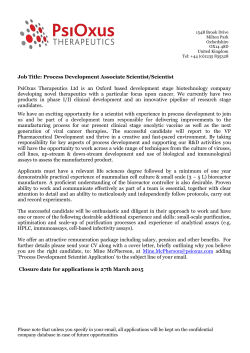
Linkages between in vitro assays and higher order in vivo endpoints
RESEARCH COUNCIL OF NORWAY; TRONDHEIM UNIVERSITY 18TH POLLUTANT RESPONSES IN MARINE ORGANISMS (PRIMO 18) SYMPOSIUM – May 24-27, 2015 http://atlanticmice.event123.no/NTNU/PRIMO18/generalinformation.cfm Linkages between in vitro assays and higher order in vivo endpoints for Menidia beryllina N. D. Denslow1, K. J. Kroll1, O. K. Adeyemo1, B. S. Jayasinghe1, C. Lavelle1, A. Mehinto2, S. Bay2, K. Maruya2 1Department of Physiological Sciences, Center for Environmental and Human Toxicology, University of Florida, Gainesville, FL, USA 2Southern California Coastal Water Research Project Authority, Costa Mesa, CA, USA Abstract The growing quantity of estrogenic contaminants that find their way into the natural environment are difficult to measure by routine analytical methods and whole animal toxicity assays. In recent years, bioanalytical assays have emerged that can quantify estrogen equivalence for these chemicals. The goal of our project was to establish quantitative linkages between the in vitro receptor-based assays and traditional endpoints of adversity in a sensitive estuarine fish model, the common silverside (Menidia beryllina). We used commercially available estrogen transactivation assays to measure in vitro EC50’s for several commonly found estrogenic chemicals and have compared these values to concentrations required to elicit changes in growth and end points important for reproduction. We have exposed fish to 17b estradiol, estrone, nonylphenol and bisphenol A and to ethinylestradiol as a positive control. In the case of strong estrogens (17b estradiol and estrone), exposures of fish to concentrations that were above the EC50 points for the in vitro assays were also sufficient to see changes in expression of genes such as vitellogenin and choriogenin, among others in fish, suggesting the in vitro assays can function as good proxies for higher order effects. The relationships are harder to establish for the weaker estrogens (nonylphenol and bisphenol A) as concentrations above the EC50 points for the in vitro assays were generally toxic to fish. In Menidia, differentiation of gonadal tissue occurs earlier in control females (starting about 40 days post hatch (dph) than in males (starting about 70 dph), and exposure to estrogens can skew the development of these tissues. These studies demonstrate that relationships can be determined between in vitro and in vivo assays to better estimate the overall effects of chemicals in the environment..
© Copyright 2025












